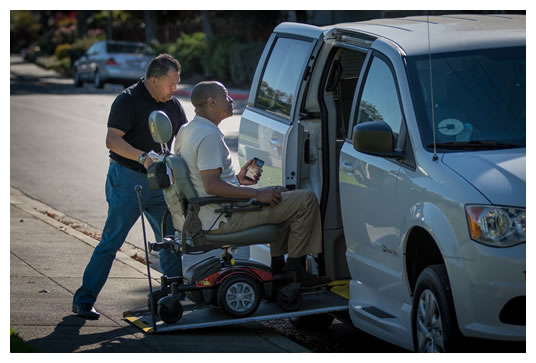Discover more about the topics and technologies that were discussed at the 2019 conference, via a series of exclusive interviews with a selection of our expert speakers.
 Malcom Glenn, head of global policy, accessibility and underserved communities, Uber, on his plans for a more inclusive future for autonomous vehicles, and how the platform is adding more wheelchair-accessible vehicles (WAVs) to its service.
Malcom Glenn, head of global policy, accessibility and underserved communities, Uber, on his plans for a more inclusive future for autonomous vehicles, and how the platform is adding more wheelchair-accessible vehicles (WAVs) to its service.
Tell us about your presentation.
Uber is already using technology to make transportation more accessible and reliable for riders from underserved communities in more than 600 cities and 64 countries on six continents. But in order to realize the most inclusive future for autonomous vehicles, we must continue to improve the accessibility of our platform today, as we won’t be able to optimize for an accessible future if we don’t make it a priority today. Our work today improving access spans different types of disabilities, geographies and income levels. This includes digital accessibility features that are available everywhere, as well as innovative models to bring wheelchair-accessible vehicles to our platform in major markets on four continents. In my presentation, I’ll talk about how we’re making accessibility a meaningful part of what we do today, and how that work will underpin the future.
How big do you estimate the transport market is for users with disabilities?
We think we’ve just started to scratch the surface of the number of users who can benefit from the Uber platform. There are more than 1 billion people in the world with some form of disability, and while all of them won’t necessarily be able to take advantage of every one of the options, expanding the platform makes it easier for more and more people to be able to use Uber. Increasingly, people are opening up the Uber app, tapping where they want to go, and choosing between a number of different options as to how to get to their destination. And the more of those options that are accessible –through digital features, wheelchair-accessible vehicles or accessible transit options –the more and the better we’ll be able to serve as many of those billion people as possible.
 What are some of the common problems they face across transport modes – and how can Uber improve on this?
What are some of the common problems they face across transport modes – and how can Uber improve on this?
The barriers are massive. The exact challenges depend on the type of disability a person has, where they are in the world and the quality of the transportation infrastructure in that place. Technology has improved the experience in many ways; the Uber app is accessible on major screen-reading platforms, and we’ve introduced policies to make clear to drivers their obligations to accommodate riders with disabilities. One of the biggest challenges is that all cars manufactured today are inaccessible for people who use motorized wheelchairs and other assistive devices. As a result, we’ve gone outside of our traditional model of Uber drivers using their own cars in order to bring wheelchair-accessible vehicles (WAVs) to our platform in major markets on four continents.
Tell us more about the innovative models you are using to bring wheelchair-accessible vehicles to your platform.
As mentioned, in most countries our platform is made up of people driving with their own cars. And while those cars can accommodate people who use folding wheelchairs, because vehicle manufacturers don’t make WAVs equipped with a ramp or a lift, we’ve had to utilize very different models for people using motorized wheelchairs. That includes recruiting and partnering with people who personally own WAVs, to working with taxi organizations to get their WAVs on our platform. We also work with renting and leasing partners who can provide WAVs to prospective drivers who want to partner with Uber but don’t own a vehicle. Another model that’s shown promise in some parts of the world is forming commercial partnerships – including the one we have with MV Transportation in North America – where companies bring their fleets of drivers and WAVs onto our app. Utilizing all of these models, we’ve made lots of progress but know we still have lots of work to do.
One assumes an AV won’t have a driver to assist disabled passengers – correct?
We’re working to build technology that can work completely without the use of a driver, though we’re still a long way from realizing that vision. More than 37,000 people die in car crashes around the world every year, and the overwhelming majority of those fatalities occur because of human error. So one of the key reasons we’re focused on building autonomous vehicle technology is because we believe it can be safer, in addition to more cost-efficient, more time-efficient, more space-efficient, more equitable and better for the environment than existing transportation options. That said, autonomous vehicles will become a part of our fleet gradually, and there will likely still be many use cases that require drivers. Over time, even as autonomous vehicles become a part of the platform, we expect the number of drivers overall to actually grow.
How do you ensure developers keep accessibility in mind? Is government regulation the answer?
We are committed to building tech that is accessible as well as leveraging relationships with vehicle manufacturers to think about accessibility as a core component of vehicle design. We’re also committed to working with disability organizations and encouraging vehicle manufacturers to do the same, all with the goal of integrating accessibility into the core of both physical and digital designs.
Don't miss Malcom's presentation Improving accessible transportation around the world, which takes place on Day 2 as part of Stream 2: Mass Deployment of Autonomous Vehicles, at the conference. For the up-to-date program, click here. To book your delegate pass, click here.